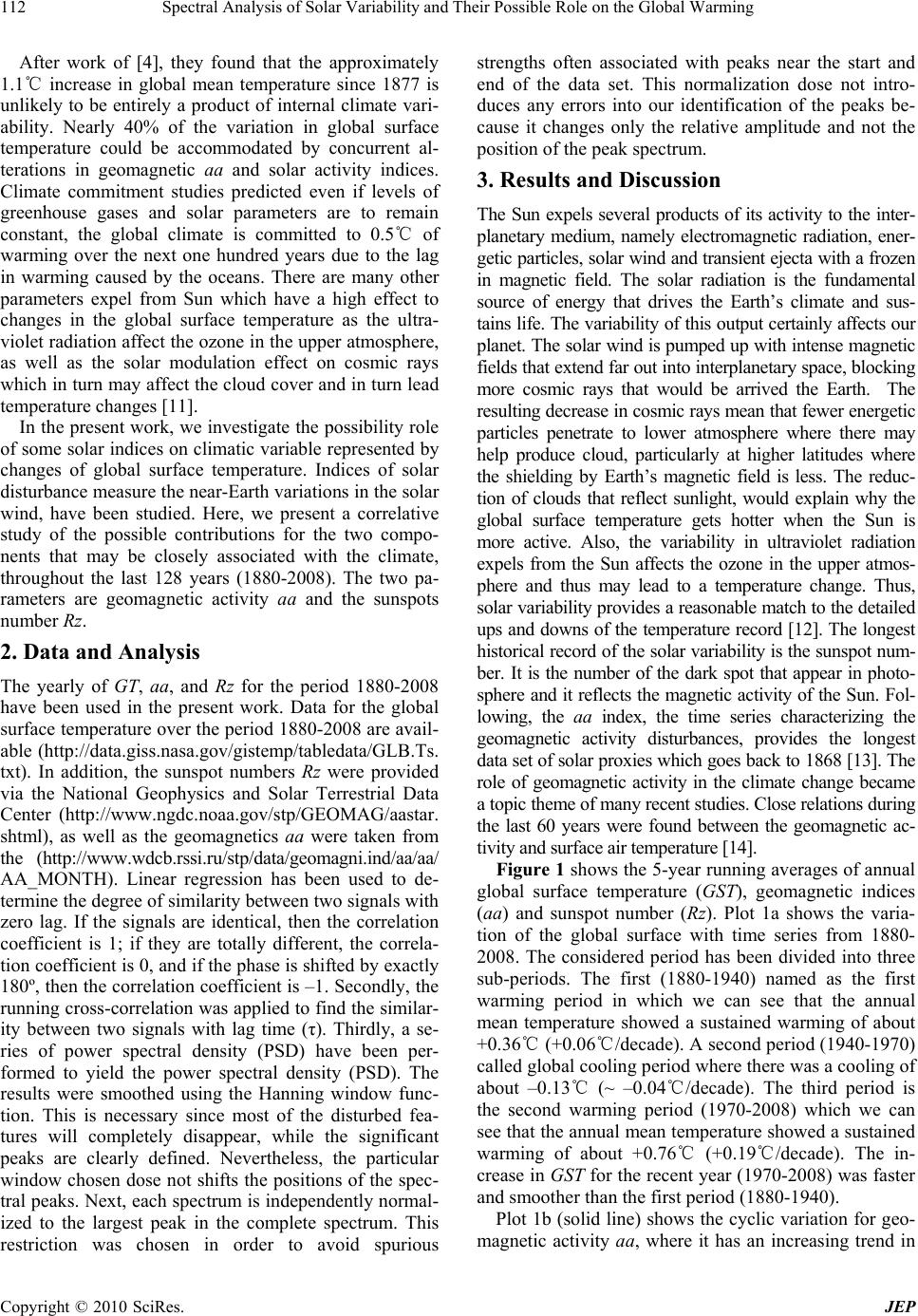
Spectral Analysis of Solar Variability and Their Possible Role on the Global Warming
112
After work of [4], they found that the approximately
1.1℃ increase in global mean temperature since 1877 is
unlikely to be entirely a product of internal climate vari-
ability. Nearly 40% of the variation in global surface
temperature could be accommodated by concurrent al-
terations in geomagnetic aa and solar activity indices.
Climate commitment studies predicted even if levels of
greenhouse gases and solar parameters are to remain
constant, the global climate is committed to 0.5℃ of
warming over the next one hundred years due to the lag
in warming caused by the oceans. There are many other
parameters expel from Sun which have a high effect to
changes in the global surface temperature as the ultra-
violet radiation affect the ozone in the upper atmosphere,
as well as the solar modulation effect on cosmic rays
which in turn may affect the cloud cover and in turn lead
temperature changes [11].
In the present work, we investigate the possibility role
of some solar indices on climatic variable represented by
changes of global surface temperature. Indices of solar
disturbance measure the near-Earth variations in the solar
wind, have been studied. Here, we present a correlative
study of the possible contributions for the two compo-
nents that may be closely associated with the climate,
throughout the last 128 years (1880-2008). The two pa-
rameters are geomagnetic activity aa and the sunspots
number Rz.
2. Data and Analysis
The yearly of GT, aa, and Rz for the period 1880-2008
have been used in the present work. Data for the global
surface temperature over the period 1880-2008 are avail-
able (http://data.giss.nasa.gov/gistemp/tabledata/GLB.Ts.
txt). In addition, the sunspot numbers Rz were provided
via the National Geophysics and Solar Terrestrial Data
Center (http://www.ngdc.noaa.gov/stp/GEOMAG/aastar.
shtml), as well as the geomagnetics aa were taken from
the (http://www.wdcb.rssi.ru/stp/data/geomagni.ind/aa/aa/
AA_MONTH). Linear regression has been used to de-
termine the degree of similarity between two signals with
zero lag. If the signals are identical, then the correlation
coefficient is 1; if they are totally different, the correla-
tion coefficient is 0, and if the phase is shifted by exactly
180º, then the correlation coefficient is –1. Secondly, the
running cross-correlation was applied to find the similar-
ity between two signals with lag time (τ). Thirdly, a se-
ries of power spectral density (PSD) have been per-
formed to yield the power spectral density (PSD). The
results were smoothed using the Hanning window func-
tion. This is necessary since most of the disturbed fea-
tures will completely disappear, while the significant
peaks are clearly defined. Nevertheless, the particular
window chosen dose not shifts the positions of the spec-
tral peaks. Next, each spectrum is independently normal-
ized to the largest peak in the complete spectrum. This
restriction was chosen in order to avoid spurious
strengths often associated with peaks near the start and
end of the data set. This normalization dose not intro-
duces any errors into our identification of the peaks be-
cause it changes only the relative amplitude and not the
position of the peak spectrum.
3. Results and Discussion
The Sun expels several products of its activity to the inter-
planetary medium, namely electromagnetic radiation, ener-
getic particles, solar wind and transient ejecta with a frozen
in magnetic field. The solar radiation is the fundamental
source of energy that drives the Earth’s climate and sus-
tains life. The variability of this output certainly affects our
planet. The solar wind is pumped up with intense magnetic
fields that extend far out into interplanetary space, blocking
more cosmic rays that would be arrived the Earth. The
resulting decrease in cosmic rays mean that fewer energetic
particles penetrate to lower atmosphere where there may
help produce cloud, particularly at higher latitudes where
the shielding by Earth’s magnetic field is less. The reduc-
tion of clouds that reflect sunlight, would explain why the
global surface temperature gets hotter when the Sun is
more active. Also, the variability in ultraviolet radiation
expels from the Sun affects the ozone in the upper atmos-
phere and thus may lead to a temperature change. Thus,
solar variability provides a reasonable match to the detailed
ups and downs of the temperature record [12]. The longest
historical record of the solar variability is the sunspot num-
ber. It is the number of the dark spot that appear in photo-
sphere and it reflects the magnetic activity of the Sun. Fol-
lowing, the aa index, the time series characterizing the
geomagnetic activity disturbances, provides the longest
data set of solar proxies which goes back to 1868 [13]. The
role of geomagnetic activity in the climate change became
a topic theme of many recent studies. Close relations during
the last 60 years were found between the geomagnetic ac-
tivity and surface air temperature [14].
Figure 1 shows the 5-year running averages of annual
global surface temperature (GST), geomagnetic indices
(aa) and sunspot number (Rz). Plot 1a shows the varia-
tion of the global surface with time series from 1880-
2008. The considered period has been divided into three
sub-periods. The first (1880-1940) named as the first
warming period in which we can see that the annual
mean temperature showed a sustained warming of about
+0.36℃ (+0.06℃/decade). A second period (1940-1970)
called global cooling period where there was a cooling of
about –0.13℃ (~ –0.04℃/decade). The third period is
the second warming period (1970-2008) which we can
see that the annual mean temperature showed a sustained
warming of about +0.76℃ (+0.19℃/decade). The in-
crease in GST for the recent year (1970-2008) was faster
and smoother than the first period (1880-1940).
Plot 1b (solid line) shows the cyclic variation for geo-
magnetic activity aa, where it has an increasing trend in
Copyright © 2010 SciRes. JEP